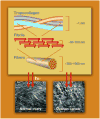Second harmonic generation imaging microscopy: applications to diseases diagnostics
- PMID: 21446646
- PMCID: PMC3104727
- DOI: 10.1021/ac1032325
Second harmonic generation imaging microscopy: applications to diseases diagnostics
Abstract
Second Harmonic Generation microscopy has emerged as a powerful new optical imaging modality. This Feature describes its chemical and physical principles and highlights current applications in disease diagnostics.
Figures






References
Publication types
MeSH terms
Grants and funding
LinkOut - more resources
Full Text Sources
Other Literature Sources
Medical

